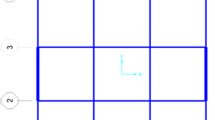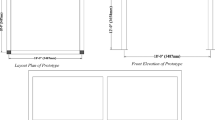Abstract
Steel concentrically braced frames (CBFs) are widely used as a seismic force resisting system (SFRS) in Canada because of their efficiency in resisting seismic loads. Several different approaches can be taken to design CBFs according to the Canadian Steel Design Standard CSA S16:19. These approaches range from moderately ductile (Type MD) CBFs, which require special detailing considerations and limits on local and member slenderness to promote the intended ductile response, to conventional construction (Type CC), which requires higher seismic design forces but has more relaxed detailing requirements. While these construction types have been defined in CSA S16:19 for many years, few studies have compared the seismic performance of frames designed using these different sets of requirements. To address this research gap, this paper compares designs for the same archetype structure using both Type MD and Type CC CBFs. Both frame types are designed according to CSA S16:19 and subsequently modelled using the advanced earthquake simulation software OpenSees. Thereafter, the models are subjected to a multiple stripe analysis (MSA) using a set of ground motions prescribed in FEMA P-695, to assess their seismic performance. A close look at the inter-storey drift time history during a typical ground motion record reveals the sequential occurrence of the different damage states, while the statistics of the inter-storey drift ratio demonstrates that the Type CC design leads to more variable performance. Finally, storey-by-storey fragility curves are developed for both construction types to compare the seismic performance.
Access this chapter
Tax calculation will be finalised at checkout
Purchases are for personal use only
Similar content being viewed by others
References
ANSI/AISC 341-16 (2016) Seismic provisions for structural steel buildings. American Institute of Steel Construction, Chicago, Illinois
ASCE/SEI 7-22 (2022) Minimum design loads and associated criteria for buildings and other structures. American Society of Civil Engineers
Baker JW (2015) Efficient analytical fragility function fitting using dynamic structural analysis. Earthq Spectra 31(1):579–599
Ballard R (2015) Impact of connection type on performance of non-seismic concentrically braced frames. Thesis submitted in partial fulfillment of the requirements of Master of Science, Dept. of Civil Engineering, University of Washington
Bradley CR, Fahnestock LA, Hines EM, Sizemore JG (2017) Full-scale cyclic testing of low-ductility concentrically braced frames. J Struct Eng 143(6):04017029
Castonguay PX (2009) Seismic performance of concentrically braced steel frame of the conventional construction catagory. Thesis submitted in partial fulfillment of the requirements of a Master’s degree in applied sciences, Dept. of Civil Engineering, Ecole Polytechnique De Montreal
CSA S16:19 (2019) Design of steel structures. Canadian Standards Association, Toronto, Ont., Canada
Elkady A, Lignos DG (2015) Effect of gravity framing on the overstrength and collapse capacity of the steel frame building with perimeter special moment frames. Earthquake Eng Struct Dynam 44:1289–1307
FEMA P-695 (2009) Quantification of building seismic performance factors. Prepared by Applied Technology Council. Prepared for Federal Emergency Management Agency
Herman D (2007) Further improvements on and understanding of special concentrically braced frame systems. Thesis submitted in partial fulfillment of the requirements of Master of Science, Dept. of Civil Engineering, University of Washington
Hsiao PC, Lehman DE, Berman JW, Roeder CW, Powell J (2014) Seismic vulnerability of older braced frames. J Perform Constr Facil 28(1):108–120
Hsiao PC, Lehman DE, Roeder CW (2012) Improved analytical model for special concentrically braced frames. J Constr Steel Res 73:80–94
Hsiao PC, Lehman DE, Roeder CW (2013) A model to simulate special concentrically braced frames beyond brace fracture. Earthquake Eng Struct Dynam 42:1–6
Johnson MM (2014) Seismic evaluation of bolted connections in non-seismic concentrically braced frames. Thesis submitted in partial fulfillment of the requirements of Master of Science, Dept. of Civil Engineering, University of Washington
Johnson SM (2005) Improved seismic performance of special concentrically braced frames. Thesis submitted in partial fulfillment of the requirements of Master of Science, Dept. of Civil Engineering, University of Washington
Kotulka BA (2007) Analysis for a design guide on gusset plates used in special concentrically braced frames. Thesis submitted in partial fulfillment of the requirements of Master of Science, Dept. of Civil Engineering, University of Washington
Lehman DE, Roeder CW, Herman D, Johnson S, Kotulka B (2008) Improved seismic performance of gusset plate connections. J Struct Eng 134(6):890–901
Liu J, Astaneh-Asl A (2004) Moment-rotational parameters for composite shear tab connections. J Struct Eng 130(9):1371–1380
McKenna FT (1997) Object-oriented finite element programming framework for analysis, algorithm and parallel computing. Ph.D. thesis, Dept. of Civil Engineering, University of California, Berkeley
NBC (2015) National building code of Canada. National Research Council of Canada. Canadian Commision on Building and Fire Codes
Powell JA (2009) Evaluation of special concentrically braced frames for improved seismic performance and constructability. Thesis submitted in partial fulfillment of the requirements of Master of Science, Dept. of Civil Engineering, University of Washington
Roeder CW, Lumpkin EJ, Lehman DE (2011) A balanced design procedure for special concentrically braced frame connections. J Constr Steel Res 67(11):1760–1772
Rudman A, Tremblay R, Rogers CA (2021) Conventional I-shape brace member bolted connections under seismic loading: laboratory study. J Constr Steel Res 184
Sen AD, Roeder CW, Lehman DE, Berman JW (2019) Nonlinear modeling of concentrically braced frames. J Constr Steel Res 157:103–120
Sen AD, Sloat D, Ballard R, Johnson MM, Roeder CW, Lehman DE, Berman JW (2016) Experimental evaluation of the seismic vulnerability of braces and connections in older concentrically braced frames. J Struct Eng 142(9):04016052
Sizemore JG, Fahnestock LA, Hines EM, Bradley CR (2017) Parametric study of low-ductility concentrically braced frames under cyclic static loading. J Struct Eng 143(6):04017032
Sloat D (2014) Evaluation and retrofit of non-capacity designed braced frames. Thesis submitted in partial fulfillment of the requirements of Master of Science, Dept. of Civil Engineering, University of Washington
Swatosh MA (2016) Seismic evaluation and retrofit of concentrically btraced frames. Thesis submitted in partial fulfillment of the requirements of Master of Science, Dept. of Civil Engineering, University of Washington
Wang C, Tremblay R, Rogers CA (2021) Component-based model for bolted brace connections in conventional concentrically braced frames. Eng Struct 247
Acknowledgements
The authors gratefully acknowledge the support of this study from Discovery Grant funding provided by the Natural Sciences and Engineering Research Council (NSERC) of Canada. Any opinions, findings, and conclusions or recommendations expressed in this material are those of the authors and do not necessarily reflect the views of the sponsors.
Author information
Authors and Affiliations
Corresponding author
Editor information
Editors and Affiliations
Rights and permissions
Copyright information
© 2023 Canadian Society for Civil Engineering
About this paper
Cite this paper
Kundu, A., Wiebe, L., Balomenos, G.P. (2023). Seismic Performance Comparison of Moderately Ductile and Conventional Construction Steel Concentrically Braced Frames. In: Gupta, R., et al. Proceedings of the Canadian Society of Civil Engineering Annual Conference 2022. CSCE 2022. Lecture Notes in Civil Engineering, vol 348. Springer, Cham. https://doi.org/10.1007/978-3-031-34159-5_18
Download citation
DOI: https://doi.org/10.1007/978-3-031-34159-5_18
Published:
Publisher Name: Springer, Cham
Print ISBN: 978-3-031-34158-8
Online ISBN: 978-3-031-34159-5
eBook Packages: EngineeringEngineering (R0)




